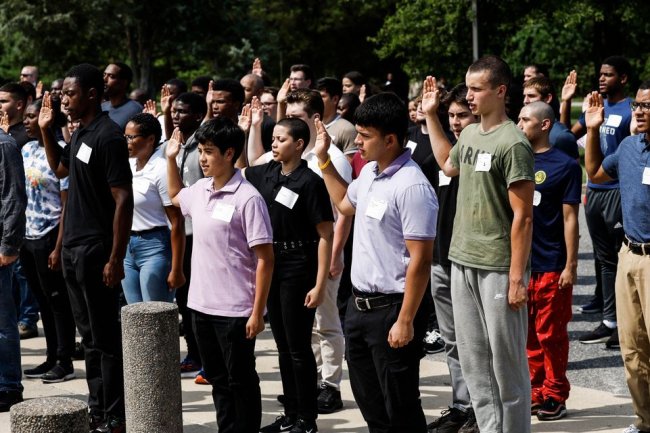Is Your Company’s DEI Program Lawful?
The Supreme Court’s ruling against affirmative action has implications beyond the ivory tower. By Michael Toth July 2, 2023 12:23 pm ET Illustration: David Klein The U.S. Supreme Court last week held racial preferences unlawful in college admissions. But executives of U.S. corporations should read Students for Fair Admissions v. Harvard closely, because it will likely end up applying to them. Many companies have pushed racial preferences and quotas under the guise of “diversity, equity and inclusion” policies that run contrary to the justices’ warning against choosing “winners and losers based on the color of their skin.” The Constitution protects individuals o


Illustration: David Klein
The U.S. Supreme Court last week held racial preferences unlawful in college admissions. But executives of U.S. corporations should read Students for Fair Admissions v. Harvard closely, because it will likely end up applying to them. Many companies have pushed racial preferences and quotas under the guise of “diversity, equity and inclusion” policies that run contrary to the justices’ warning against choosing “winners and losers based on the color of their skin.”
The Constitution protects individuals only from government actions. But Fair Admissions applied the 14th Amendment’s Equal Protection Clause to Harvard and other private universities by way of Title VI. That section of the Civil Rights Act of 1964 prohibits discrimination “on the ground of race, color, or national origin” by “any program or activity receiving Federal financial assistance.”
Title VII of the 1964 act, as Justice Neil Gorsuch notes in his concurring opinion, applies the same antidiscrimination principles to private businesses with more than 15 employees. They are liable for damages if they discriminate on the basis of “race, color, religion, sex, or national origin.”
The majority opinion in Fair Admissions doesn’t mention Title VII, and there is precedent affirming the use of race as a factor in hiring. In Steelworkers v. Weber (1979), the court interpreted Title VII to permit what Justice William Brennan called “an affirmative action plan voluntarily adopted by private parties to eliminate traditional patterns of racial segregation.”
Yet it is difficult to imagine Steelworkers coming out the same way in today’s court. Steelworkers included a lengthy dissent from Justice William Rehnquist, who called the majority’s reasoning “Orwellian”: “The Court eludes clear statutory language, ‘uncontradicted’ legislative history, and uniform precedent in concluding that employers are, after all, permitted to consider race in making employment decisions.”
John Roberts, who clerked for Rehnquist in 1980-81 and succeeded him as chief justice in 2005, wrote the majority opinion in Fair Admissions. Chief Justice Roberts has long carried Rehnquist’s antidiscrimination torch in opinions lamenting the “sordid business” of “divvying us up by race” and urging: “The way to stop discrimination on the basis of race is to stop discriminating on the basis of race.” But unlike Rehnquist, his successor is joined on the court by five justices committed to adhering to the text of law. It is likely they will carefully scrutinize racial preferences under Title VII.
To avoid liability, companies should closely examine their DEI policies. Many companies publish demographic targets of their future workforce and leadership ranks. The manufacturing giant 3M announces on its website that its aim is to “double the representation of underrepresented groups from entry-level through management in our U.S. workforce.” In 2021, United Airlines launched a plan “to train 5,000 new pilots by 2030, at least half of them women and people of color.” McDonald’s has tied executive compensation to reaching specific percentages of women and minorities in senior positions.
However well-intentioned, these goals stand out against the backdrop of Fair Admissions. The majority opinion criticizes Harvard and the University of North Carolina for trying to conceal what many companies flaunt: the use of numerical benchmarks and specified percentage goals based on race. As Chief Justice Roberts explains, “outright racial balancing” turns the principle of equal protection on its head. Even in earlier cases upholding colleges’ use of racial preferences, the justices expressed their serious reservations about racial quotas, which is why Harvard and UNC went to such lengths to deny using them.
Employers should take into account Fair Admissions’ formulation of the “twin commands” of equal protection: “that race may never be used as a ‘negative’ and that it may not operate as a stereotype.” The former command calls into serious question the use of race as a “plus factor” in hiring and promotion. As in college admissions, employment decisions are zero-sum: Giving a leg up to some job applicants on account of race or sex but not others “necessarily advantages the former group at the expense of the latter,” according to Fair Admissions.
The latter command calls for a searching analysis of the genuine goals of workplace diversity. Fair Admissions rejected the broad and amorphous justifications for racial preferences advanced by Harvard and UNC, such as that these policies broaden knowledge, foster innovation and enhance empathy. Companies that base their DEI policies on similar grounds should either scrap their policies or reformulate them in a way that is, in the words of the majority opinion, “sufficiently coherent for purposes of strict scrutiny.” Additionally, businesses should note that the court in Fair Admissions refused to defer to universities on why admitting students from certain racial or ethnic categories was necessarily tied with the goals that it was pursuing. Companies shouldn’t count on receiving more leeway.
Companies should also ensure that diversity training doesn’t create a hostile workplace environment, a well-recognized form of employment discrimination under Title VII. Here, the lawsuits have already begun. Two years ago, Leslie Chislett, a New York City public-school teacher sued the city on the basis of mandatory diversity training sessions where she was allegedly told that her “interest in excellence was . . . consistent with White Supremacy.” While courts are unlikely to micromanage human-resource presentations, mandatory employee training that is overtly hostile to employees on the basis of their race is likely to put companies in legal harm’s way.
For American businesses, Fair Admissions is an invitation to reground their hiring practices and DEI initiatives around equal opportunity and genuine inclusivity that, as Chief Justice Roberts puts it, “treats citizens as individuals, not as simply components of a racial, religious, sexual or national class.” In other words, stop discriminating on the basis of race. Racial quotas, no matter how well-intentioned, are still discrimination. If C-Suites don’t get the message, they may have to explain themselves in court. And for those companies that believe that they are too big or too important to be affected by legal requirements for across-the-board racial equality, ask Harvard how that went.
Mr. Toth is an attorney in Austin, Texas.
Journal Editorial Report: Colleges vow to keep race a factor in admissions. Images: AP/Getty Images/Zuma Press Composite: Mark Kelly The Wall Street Journal Interactive Edition
What's Your Reaction?













